teaching animals
Download as ppt, pdf0 likes231 views
The document states that there are 5 birds flying in the sky. It describes birds flying and states the number of birds as 5.
1 of 12
Download to read offline


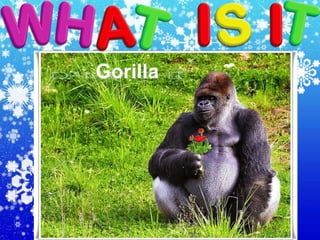
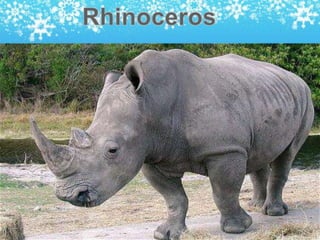
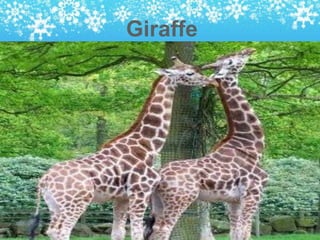
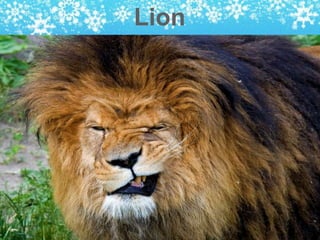

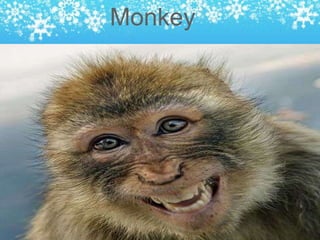
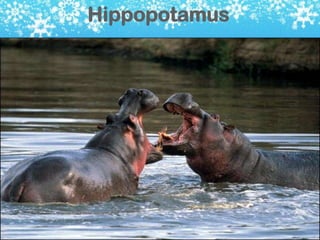

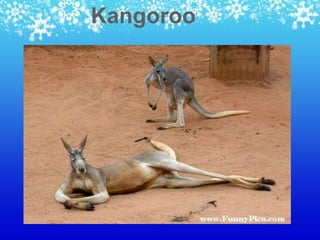

Ad
Recommended
Butterfly Life Cycle for kids
Butterfly Life Cycle for kidsMake Megenius
╠²
The butterfly life cycle involves four stages: an egg, caterpillar, pupa, and adult butterfly. A butterfly first lays eggs on a plant leaf. The caterpillar hatches and eats leaves as it grows, shedding its skin several times. It then spins a silk pad and enters the pupa stage inside a protective shell. Finally, the adult butterfly emerges from the shell with wet wings and gulps air to expand and dry them before flying off to find nectar.Butterfly life cycle pippin
Butterfly life cycle pippinSyed Shah
╠²
The document describes the four stages of a butterfly's life cycle: an egg is laid on a leaf and hatches into a caterpillar, the caterpillar eats voraciously and then forms a chrysalis inside a cocoon for two weeks, emerging as a beautiful butterfly. Additional facts provided state that butterflies can see certain colors, have four wings and antennae to help them see, female butterflies are larger than males, and butterflies fly between flowers to eat nectar.Frightful's mountain
Frightful's mountainSemhar Ghebreselasie
╠²
The document discusses different terms related to birds of prey:
- Frightful is a peregrine falcon, an aggressive hawk that attacks anything coming too close.
- A tiercel is a male hawk, specifically a peregrine or goshawk.
- An escarpment is an area where elevation changes suddenly, referring to the bottom of a steep hill or slope, and peregrine falcons often build their nests called aeries high up on cliff escarpments.Butterfly metamorphosis power point game
Butterfly metamorphosis power point gamePhil Haddad
╠²
The document is a quiz about the lifecycle of butterflies. It covers the four stages of a butterfly's lifecycle (egg, caterpillar, chrysalis, butterfly), where caterpillar eggs are found, that caterpillars are also called larvae, details about the chrysalis stage such as how long monarch butterflies spend in their chrysalis, and that monarch butterflies can start flying about an hour after emerging from their chrysalis. The quiz contains multiple choice questions to test the reader's knowledge of the butterfly lifecycle.Ask The Geese
Ask The Geeseguest539768
╠²
Geese fly in a V formation to increase their flying range. By flying in formation, each goose creates uplift for the goose behind it, allowing the flock to travel up to 71% further than if each goose flew alone. Any goose that falls out of formation feels increased drag and quickly returns to its place. Just as geese work as a team by sharing leadership and encouraging each other, people can accomplish more by cooperating rather than trying to go it alone.Where do animals live? (ScienceandEnglish.com)
Where do animals live? (ScienceandEnglish.com)JuanOrtizPareja
╠²
The document discusses different types of animals. It describes domestic and wild animals and notes that some animals live on land, in water, or in trees. It then explains that some animals are herbivores that eat plants, some are carnivores that eat meat and fish, and some are omnivores that eat both plants and meat. The document also discusses how some animals lay eggs while mammals give live birth and feed their young with milk. It provides examples of different mammals, birds, and their key characteristics.Mammals and birds
Mammals and birdslolijisa
╠²
This document discusses the characteristics of mammals and birds. Mammals have hair or fur, are viviparous meaning babies are born from the mother's womb and drink milk. Examples given are cats, sheep, giraffes, elephants, monkeys, lions, dogs, horses, tigers, pigs, and humans. Birds have feathers and wings, are oviparous meaning they are born from eggs, and eat insects and worms.Serendip Walk
Serendip Walkmrs_ob
╠²
Ducks use their beaks to eat and dive, while young ducks can dive for long periods. Kangaroos travel in mobs and have good hearing, and emus can run fast but cannot fly. Male brolgas perform mating calls to attract females and do not like other brolgas nearby. Beaks help birds and ducks obtain food and defend against enemies, and they come in many shapes. Kangaroos can jump the farthest at 2 meters, wallabies jump 1.5 meters, and pademelons jump 0.8 meters. The nocturnal tawny frogmouth camouflages itself in trees.Butterflies Interactive Powerpoint
Butterflies Interactive Powerpointlongstrr
╠²
This document provides information about butterflies, including their anatomy, life cycles, habitats, and common species. It describes how butterflies drink nectar rather than eating, how their scales provide color and protection, and the four stages of a butterfly's life cycle: egg, caterpillar, pupa, and adult. Videos and photos show the birth of a butterfly from its chrysalis. The document also lists resources for further information.Mammals blog
Mammals blogcarmencondebilingue
╠²
Mammals are animals that are born live, have hair, and four legs. They breathe with lungs, have bones inside their bodies, and baby mammals drink milk from their mothers. Common characteristics of mammals include giving live birth, having hair, and possessing four legs.Painted Lady Butterfliespresentation2
Painted Lady Butterfliespresentation2Ellen Zelinske
╠²
The document summarizes the life cycle of a painted lady butterfly, which includes four stages: egg, larva (caterpillar), pupa (chrysalis), and adult butterfly. It describes the appearance and behaviors of the butterfly at each stage, such as how the caterpillar eats voraciously before forming a chrysalis and emerging 10 days later as an adult butterfly. The document also identifies and defines the main anatomical parts of an adult butterfly.Painted lady butterflies
Painted lady butterfliesEllen Zelinske
╠²
The document describes the four life stages of the painted lady butterfly: egg, larva/caterpillar, pupa/chrysalis, and adult butterfly. It explains that the caterpillar eats voraciously before forming a chrysalis and undergoing complete metamorphosis over 10 days to emerge as an adult butterfly. Key physical features of each life stage and the adult butterfly are identified, including its proboscis, antennae, compound eyes, and ability to taste, breathe, hear and drink nectar. Games and activities are provided to help learners identify butterfly parts and life stages.Insect powerpoint presentation
Insect powerpoint presentationąĪč鹥čäą░ąĮ ąłąŠčłąĖčø
╠²
This document appears to be a collection of student presentations about various insects and spiders. It includes descriptions of wolf spiders, tarantulas, flies, butterflies, black widows, daddy long legs, mealworms, ladybugs, scorpions, swallowtails, trapdoor spiders, and widows. Each presentation provides details about what the insect or spider eats, where it lives, whether it flies or not, and if it has a complete life cycle. The students described physical characteristics and behaviors of the different bugs.Animals II
Animals IIfgmavi1
╠²
Mammals are defined as having live babies, hair, and drinking milk from their mother. They breathe with lungs, many have four legs, and examples given include cows, monkeys, zebras, bats, lions, cats, and humans. The document repeats that mammals have live babies, hair, and provides examples of different types of mammals.Emily & Bree's Design a Mammal
Emily & Bree's Design a MammalTery Casey
╠²
This document describes a fictional animal called a camongiroo that was genetically engineered by combining traits from kangaroos, giraffes, camels, and chimpanzees. It lives on a hot, dry planet covered in sand with little grass and tall trees only bearing leaves at the top. Camongiroos live in herds of up to 9 and protect their young. They reproduce every 3-4 years but most babies do not survive due to predators. Their main predator is the dabajy bird which can kill camongiroos through infection.More Related Content
What's hot (7)
Butterflies Interactive Powerpoint
Butterflies Interactive Powerpointlongstrr
╠²
This document provides information about butterflies, including their anatomy, life cycles, habitats, and common species. It describes how butterflies drink nectar rather than eating, how their scales provide color and protection, and the four stages of a butterfly's life cycle: egg, caterpillar, pupa, and adult. Videos and photos show the birth of a butterfly from its chrysalis. The document also lists resources for further information.Mammals blog
Mammals blogcarmencondebilingue
╠²
Mammals are animals that are born live, have hair, and four legs. They breathe with lungs, have bones inside their bodies, and baby mammals drink milk from their mothers. Common characteristics of mammals include giving live birth, having hair, and possessing four legs.Painted Lady Butterfliespresentation2
Painted Lady Butterfliespresentation2Ellen Zelinske
╠²
The document summarizes the life cycle of a painted lady butterfly, which includes four stages: egg, larva (caterpillar), pupa (chrysalis), and adult butterfly. It describes the appearance and behaviors of the butterfly at each stage, such as how the caterpillar eats voraciously before forming a chrysalis and emerging 10 days later as an adult butterfly. The document also identifies and defines the main anatomical parts of an adult butterfly.Painted lady butterflies
Painted lady butterfliesEllen Zelinske
╠²
The document describes the four life stages of the painted lady butterfly: egg, larva/caterpillar, pupa/chrysalis, and adult butterfly. It explains that the caterpillar eats voraciously before forming a chrysalis and undergoing complete metamorphosis over 10 days to emerge as an adult butterfly. Key physical features of each life stage and the adult butterfly are identified, including its proboscis, antennae, compound eyes, and ability to taste, breathe, hear and drink nectar. Games and activities are provided to help learners identify butterfly parts and life stages.Insect powerpoint presentation
Insect powerpoint presentationąĪč鹥čäą░ąĮ ąłąŠčłąĖčø
╠²
This document appears to be a collection of student presentations about various insects and spiders. It includes descriptions of wolf spiders, tarantulas, flies, butterflies, black widows, daddy long legs, mealworms, ladybugs, scorpions, swallowtails, trapdoor spiders, and widows. Each presentation provides details about what the insect or spider eats, where it lives, whether it flies or not, and if it has a complete life cycle. The students described physical characteristics and behaviors of the different bugs.Animals II
Animals IIfgmavi1
╠²
Mammals are defined as having live babies, hair, and drinking milk from their mother. They breathe with lungs, many have four legs, and examples given include cows, monkeys, zebras, bats, lions, cats, and humans. The document repeats that mammals have live babies, hair, and provides examples of different types of mammals.Emily & Bree's Design a Mammal
Emily & Bree's Design a MammalTery Casey
╠²
This document describes a fictional animal called a camongiroo that was genetically engineered by combining traits from kangaroos, giraffes, camels, and chimpanzees. It lives on a hot, dry planet covered in sand with little grass and tall trees only bearing leaves at the top. Camongiroos live in herds of up to 9 and protect their young. They reproduce every 3-4 years but most babies do not survive due to predators. Their main predator is the dabajy bird which can kill camongiroos through infection.teaching animals
- 1. Example fly on the sky 5 birds There are There are 5 birds fly on the sky
- 2. ŌĆóMy cat /sleeps /under /the blue /blanket. ŌĆóThe baby duck /swims /on the lake. ŌĆóThere /are /10 horses /in the zoo. ŌĆóShe /feeds /her dog /twice a day.
- 3. Gorilla
- 5. Giraffe
- 6. Lion
- 7. Walrus
- 8. Monkey
- 9. Hippopotamus
- 10. Dog
- 11. Kangoroo
- 12. Duck
